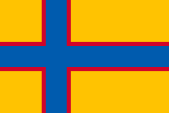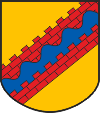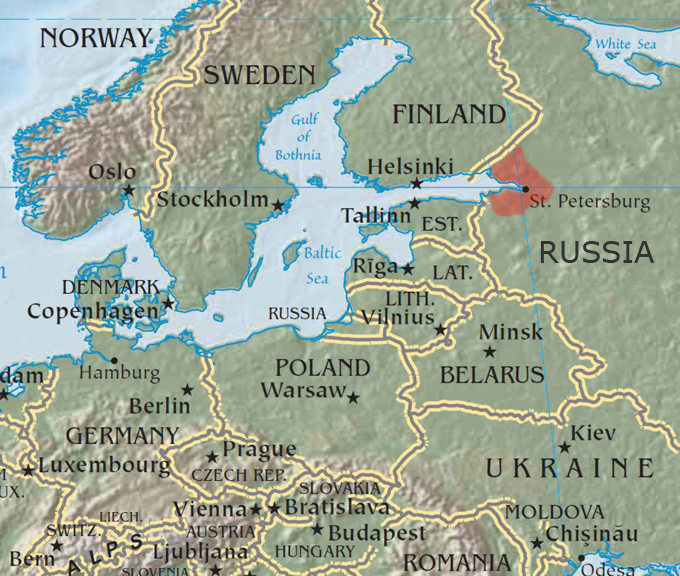mobile View, to the German Version tap the flag


- also: Ingermanland
- region with a special cultural identity within Russia
- own name: Inkeri
• Flag
• Meaning/Origin of the Flag
• Coat of Arms
• Meaning/Origin of the Coat of Arms
• Map
• Numbers and Facts
• History and additional Informations
• Origin of the Country's Name

National flag,
Source, by: Wikipedia (EN)




The flag of Ingria remembers on the one hand powerfully the swedish flag, seeing that it belongs to the years 1719/1720 to Sweden, and was settled under the swedish reign by Fins. To accent the finnish identity of the inhabitants of Ingria were inserted narrow red separating stripes. Red is the scutcheon colour and the national colour of Finland. On the other hand, the colours could also simply go back to the coat of arms.
Source:
Volker Preuß


Coat of arms of Ingria,
Source:
Wikipedia (DA)

The coat of arms of Ingria dates back to the Swedish period. It is found in the Great Seal of King Charles XII. It shows a river between two walls. It is said to symbolize the river Neva between the walls of the fortress Nyenskans. The seal is a draw that does not represent colors. In this respect, the colours are considered as probably. The river in blue, the walls in red, that's for sure. The base could have been in any color. Yellow (gold) was considered to be obvious for Swedish coats of arms.
Source:
Wikipedia (DA)

Location:

Source: Freeware, University of Texas Libraries, modyfied by: Volker Preuß

Area: ca. 5.800 square miles
Inhabitants: ca. 6.000.000, thereof 90.000 Finns
Density of Population: 1.036 inh./sq.mi.
Capital: today's importantst town: Sankt Petersburg, 5.100.000 inh.
official Language: Russian
other Languages: Finnish
Currency: Russian currency
Time Zone: GMT + 3 h
Source: UNPO

This text was found on the website of the UNPO as an Ingerman country was still a member of this organization:
General: Inkeri (Ingermanland, Ingria) historical landscape in northwestern Russia, south of the Finnish sea bosom and the Ladoga Sea and on both banks of the Neva. In the West, Ingermanland is bordered by Estonia and in the south and east along the rivers Luga, Oredezh, Tosna, Mga and Lovat. The area is about 5.800 q.mi.
Population: 6 million inhabitants, of which even in St. Petersburg about 5 millions, mostly Russians. The number of Ingermanland Finns, the historically the state-carrying nation, is 90.000, mostly living in St. Petersburg and the surrounding area. Many of them also live in Karelia, central regions of Russia, Central Asia, Finland, Estonia, Sweden, Canada, in the USA and Australia.
Language: The Ingermanland Finns belong to the Finno-Ugric peoples. Their literary language is Finnish, but is mixed with local dialects in speaking. Until 1995, Finnish was not taught in schools, the official language was and is Russian.
Organization: The Ingermanland Finns are represented in the UNPO by the Inkeri Liitto Organization. Their goal is to preserve the Ingrian Finns as a people.
Economy: Traditional forms of agriculture are partly well preserved, although most of the Ingermanland Finns work in the industrial plants of St. Petersburg and its surroundings or in the forestry sector.
History: In the 17th century Ingermanland came under Swedish rule, Finnish peasants immigrated. In 1702 the Russian Tsar Peter the Great gained access to the Baltic Sea and founded there, in Ingermanland, the new capital of his empire - Saint Petersburg.
From 1700 to 1721 Nordic War, fought the rule in the Baltic Sea and its peripheral countries in Northern and Eastern Europe, in which Denmark, Saxony, Poland and Russia, and since 1713 also Prussia and Hanover fought against Sweden. King Charles XII. of Sweden defeated in 1709 against Peter the Great near Poltava. The most important results of the peace agreements of Stockholm (1719/20), Frederiksborg (1720) and Nystad (1721): Hanover gets Bremen and Verden; Prussia gets Western Pomerania with Stettin, Usedom and Wollin; to Russia came Livonia, Estonia, Osel, Ingermanland and parts of Karelia; Sweden had to drop its old Gottorf allies (the sideline of the Oldenburg-Danish royal family) and withdrew its dominant position in the Baltic Sea region to the rising Russia. In 1920 Ingermanland was recognized in the Treaty of Tartu as part of Soviet Russia. From 1929 to 1936, the majority of Ingermanland Finns were deported to Siberia, Central Asia and the Kola Peninsula. The settlements, vacated in this way, were settled by settlers from Russia. In 1943 the population of Ingermanland was evacuated from those parts of the country, which were occupied by the German Wehrmacht, to Finland. In 1988 the organization of the Ingermanland Finns was founded. Its name is Inkeri Liitto and it was admitted to the UNPO in 1992. In 1993, the Ingermanland Finns were rehabilitated by the Russian government but it was not given the right to return to their homeland. In 1995 were opened three old people's homes, built by Inkeri Liitto with the help of the Finnish government and social organizations. The first Finnish school was opened in St. Petersburg. The Russian policy continues to violate the rights of the Ingermanland Finns. They are not recognized as an ethnic minority, nor as a native population. The local authorities have made no decision regarding the national cultural status of the Ingermanland Finns. So far, no improvement has been achieved in the struggle of the Ingerians for their self-determination. It is difficult to raise a strong voice against the Russian authorities.

Ingria, the name of the country goes back to the Finnish inhabitants of the country, the western Finnish tribe of the Izhorians (Ingrians). In German they are called Ingrians or Ingers, in Russian Ishores, in Finnish Ingrikot. The proportion of Ingrians within the Finns living in Ingria is 1%.
Source:
Wikipedia (DE),
Pierer's Universal-Lexikon


![]()






